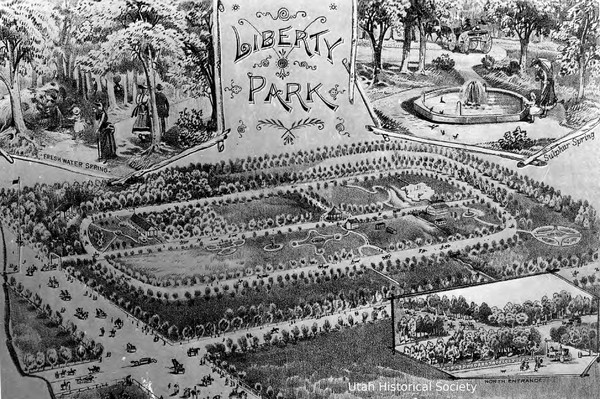Dublin Core
Title
Description
By the end of the nineteenth century, rapid urban growth and industrial smoke in Salt Lake County threatened open natural spaces. Where farmland and rural areas in the Salt Lake Valley turned increasingly urban, the open natural spaces offered by public parks gave city residents some breathing room and a small taste of the countryside.
One of the earliest and largest urban parks in Utah is Liberty Park, located along 7th East and 13th South in Salt Lake City. The park's original five acres once served as a grist mill and farm. When the city purchased the land from Brigham Young’s estate in 1881, it was in the spirit of social reform. Following the example of New York City's Central Park, the design of Liberty Park was heavily influenced by the Victorian ideal of nature as an antidote for the effects of industrialization.
Soon after the park was dedicated, the city hired a superintendent and worked with a landscape gardener to design the grounds. The early landscaping included recreational areas, open green spaces, and an oval ring-road looping the perimeter. Several small paths allowed visitors to amble through the park, taking in their natural surroundings. At Liberty Park's opening celebration, one speaker remarked that sometimes “the beautiful is as useful as the useful, perhaps more so.”
In the early 1900s, Liberty Park was at the center of an all-too-familiar controversy over clean air. Nearby smelter smoke threatened the park’s foliage and the neighborhood’s air quality. Shortly after Salt Lake City Mayor John Bransford identified smoke reduction as an urgent need, many of the smelters in the central valley closed. The desire to preserve natural oases in urbanizing areas was part of a larger movement to beautify cities and improve the moral character of urbanites.
Today, Liberty Park still serves its original purpose. The park provides ample opportunity for residents to recreate or otherwise enjoy the natural environment. The grounds are now lined with mature trees that provide a sense of seclusion amidst an otherwise bustling urban area. Although Liberty Park has significantly changed over the course of the last century, it remains a valuable resource for Salt Lake City residents to get outside and play.
Creator
Source
______________
See US Department of the Interior, National Park Service, “National Register of Historic Places Registration Form: Liberty Park,” (Utah, 1980); “Liberty Park,” Salt Lake City Public Lands Department; “How America’s Public Parks Were Born,”Smithsonian Magazine, 01:50; Brad Westood and Cassandra Clark, “The Progressive Era, the Making of a Proper Park, and the ‘Stockades’,” Utah Department of Community and Cultural Engagement; Paige Wiren, “Liberty Wells Historic District,” Utah Stories, July 24, 2019; Lynn Arave, “Liberty Park Has Been an Oasis in City Since 1881,” Deseret News, October 18, 2010; Pablo Gonzalez, “Liberty Park,” Utah Historical Markers; Kerri Cronk, “How Liberty Park has Changed in the Last 142 Years,” Fox 13, June 14, 2024.

